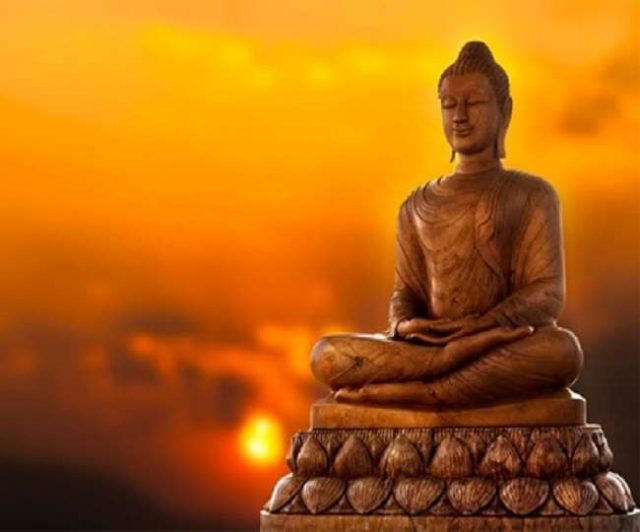
– Ananth Seth
The full moon day of the Vaisakha month of the Indian Calendar is celebrated as Buddha Poornima. It was on this tithi (date, in the Indian and Hindu parlance and system), about 2600 years ago, that Gautam Buddha, the founder of Bouddh Religion (Buddhism) was born. Though informally called “Buddha’s Birthday,” it actually commemorates the birth, enlightenment (Nirvāna), and death (Parinirvāna) of Gautama Buddha, in the Theravada tradition of Buddhism. Dr. Bhimrao Ramji Ambedkar, India’s first Law and Justice Minister, initiated Public holiday on Buddha Purnima.
THE SIMILITUDES
As is the case with religious precepts of other dharmic religions, Buddhist religious teachings too are considered as having Hindu thought as the basis. Gautama Buddha is venerated as a manifestation of God by Hindus. Many Hindu scriptures viz. Harivamsa, Vishnu Puran, Bhagavat Puran, Garuda Puran, Agni Puran, Naradiya Puran, Ling Puran, Padma Puran and Brihat Parashara Hora Shastra mention Buddha as one of the incarnations of Lord Vishnu.
Perceptions regarding Buddha, particularly amongst staunch Hindu nationalists, are that Buddha did not break away from the spiritual realm of the era, country and religion he was born into. Former President of India, Sarvepalli Radhakrishnan, claimed that there is much in common between Buddhism and the contemporary Hinduism and that nowhere did Buddha expressly repudiate the Upanishadic conception of Brahman, the “absolute.” Pali scholar Rhys Davids contends that the notion that Buddha veered away from the Hindu spirituality is a misconception and that Buddha was born, brought up, lived, and died a Hindu. Buddhologists like K.R. Norman and Richard Gombrich argue that Buddha’s Anatta theory does indeed extend to the Brahmanical belief expounded in the Brihadaranyaka Upanishad that the Self (Atman) is the Universal Self, or Brahman. They point to the Pali Alagaddūpama-Sutta, where Buddha argues that an individual cannot experience the suffering of the entire world. Gombrich even went to the extent of asserting that Buddha did not begin or pursue social reforms, nor was he against caste altogether, rather his aim was the salvation of those who joined his monastic order. Gombrich adds that modernists keep picking up these “erroneous assumptions” from western authors. Chaubis Avtar, a composition in Dasam Granth, a Sikh scripture traditionally and historically attributed to Guru Gobind Singh ji, mentions Buddha as the 23rd avatar of Vishnu.
To counter those who contend that Hindu interpretation of Buddhist thought is based on expediency and that there is no uniformity in the Hindu interpretation of Buddhist thoughts, Buddhologist Donald Swearer argues that even within Buddhism, Buddha and his ideas are conceptualized differently between Theravada, Mahayana, Tibetan, Japanese and other traditions. For that matter, even Ambedkar, the arguably the “most famous” Indian Buddhist, reinterpreted Buddha’s teachings into what he called Navayana (New Vehicle), wherein he developed a Marxist interpretation of said teachings. He founded and converted to a new version of Buddhism, a version which criticized Theravada and Mahayana schools of Buddhism.
The argument that Buddhist religious discourse had Hindu thoughts as the basis is further reinforced by the following:
i. In the early Buddhist Texts, Buddha himself referenced some Hinduistic devices (for example, in Samyutta Nikaya No. 111, Majjhima Nikaya No. 92 and Vinaya No. 246 of the Pali Canon, the Buddha praises the “Agnihotra” as the foremost sacrifice and the Gayatri mantra as the foremost meter.
ii.The Buddhist teaching of the three marks of existence may also reflect Upanishadic or other influences according to K.R. Norman.
iii. The “meditation without breath and reduced intake of food” which Buddha practiced before his awakening are forms of asceticism which are similar to Hindu practises of Pranayama and Upavaasa.
iv. The Buddhist practice of Brahma-vihara has apparently originated from a Hindu term and translates to “the abode of Brahma”.
THE DICHOTOMY AND THE CONSEQUENCES
Buddhism was strongly organized under the concept of Sangha. Its impact on the masses was profound and the tilt of Buddhist philosophy towards renunciation and monkhood had gained a lot of resonance. However, it was also a cause of concern for the spiritual leaders since sections of society who were involved in protection were also tilting that way.
By the time, Adi Shankaracharya came on to the scene, there was a marked deviation in many of the practises that later day Buddhist scholars were propounding. Shankara saw that Buddha’s concepts had their merits and it was not right that people had to choose between ‘Sanatana Dharma’ and ‘Buddhism’. Shankara sought to reunite the ideas and thus was born the Advaita School of philosophy. Shankara’s endeavors, followed and extended by the efforts of Madhvacharya, Ramanuja and Paramahamsa, ensured that masses understood the universal Oneness.
THE IDEAL
While civilizational duels and debates can and would continue, we as dharmic beings of 21st century need to ruminate on the possibilities of confluence of ideas and actions amongst the dharmic religions.
I would like to conclude with Sangham Sharanam Gachchaami, leaving the interpretation of the word Sangham to the reader!














